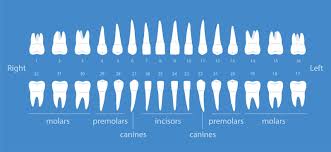Do You Know How Many Teeth You Have?
Have you ever wondered how many teeth we have? Or are you curious about the role of different types of teeth? Teeth help you bite and chew food. It also plays an important role in speaking. In addition to this, teeth provide great support for the face structure.
The number of teeth should consider the factor of age, as children and adults have different numbers of teeth.
Baby teeth
Children start teething when they are about 6 months old. The official name for early
teeth is deciduous teeth. “Deciduous” refers to fallen leaves, a metaphor for deciduous
teeth that will eventually fall out. Children have a total of 20 deciduous teeth, 10 in each
row. These teeth prepare the room for future permanent teeth. Although deciduous
teeth will eventually fall out, it is recommended to protect them just like permanent
teeth. When the child starts teething, it is time for them to develop healthy eating and
brushing habits. Generally, children begin to lose their teeth around age 6, and
permanent teeth replace the lost baby teeth. The process of changing teeth will
continue into age 10s.
Permanent teeth
Adults have more teeth than children, and most adults have 32 teeth. These include 8 incisors, 4 canines, 8 small molars and 12 large molars (including 4 wisdom teeth). Most people get all their permanent teeth in their teens. However, there is usually not enough room in the mouth for wisdom teeth to grow. While the wisdom teeth grow, they may squeeze and make other teeth shift. Due to this reason,
many adults like to extract wisdom teeth.
So, on average, children have 20 teeth and adults have 32 (28 after wisdom teeth removal).
And how about the function of each part of teeth? Typically, there are four types of teeth in the mouth. Each type has slightly different functions.
Front teeth(incisors)
Usually, the fore teeth are referred to as the front teeth. There are eight incisors in total: four in the upper row and four in the lower row. The function of the front teeth is to help bite off food and assist in pronunciation when speaking. At the same time, the front teeth also support the lips.
Canine teeth
There is one canine tooth on each side of the upper and lower incisors. Humans have a total of four canine teeth. Dentists often call these pointed teeth “fangs”. So, if you hear a dentist mention: fangs, that means they are talking about the canine tooth. Like the incisors, the canines can sever or tear food to aid in eating and digestion. The canine teeth also aid to support the lips. Additionally, the canines help guide the teeth into their proper position when the upper and lower jaws are closed.
Premolars (small molars)
The premolars are behind the canines and dentists often call them biceps. The small molars are part of the permanent teeth. It is a transitional tooth with the characteristics of canines and molars, which can cut food and can also move food from the front teeth to the molars for chewing. The premolars have flat occlusal surfaces and are being used for chewing food. They are used to maintain the height of the face. There are eight premolars in total: four on the top and four on the bottom.
Molars (large molars)
Next to the premolars are the molars, which are the widest and flattest teeth on the occlusal surface. There are 12 molars in total: six on the top and six on the bottom. Of the 12 teeth, the wisdom teeth are the four molars at the end of the lower and upper jaw. As you know, wisdom teeth are the last teeth to pop up in adulthood and are usually accompanied by pain when they erupt. Like the premolars, the molars are used to chew food and maintain the height of the face. Here gives an interesting tidbit: the upper molars have three roots, and the lower molars have two roots.
Supernumerary teeth
Supernumerary teeth, which are extra teeth in the mouth, sometimes occur when teeth develop abnormally. The most common supernumerary teeth are the incisors. It is usually located between the two middle incisors and is also known as the median overgrowth. If there is an extra molar, it is also called a paramolar. If they are located behind the third molars, they are called distal molars. In addition, supernumerary teeth may also appear in canines.
In the previous Guinness World Records, an Indian man grew 37 teeth which included wisdom teeth. He had 5 more teeth than normal people and was rated as the person with the most teeth in the world.
Birth teeth
Most babies are born without teeth. But birth teeth – having teeth as soon as babies are born, is something that needs to be noticed. Birth teeth (also known as viviparous teeth) usually appear in the lower row of gums. Birth teeth often have weak roots or no roots at all, so they can easily come loose from the gums. Doctors usually recommend extracting it to prevent the baby from accidentally swallowing the tooth. Birth teeth also pose other risks. When breastfeeding, birth teeth can irritate the baby’s tongue or bite the mother. Teething is usually an independent event, but it can also be a symptom of other medical conditions.
Now, you know about the various types of teeth, including incisors, canines, premolars, molars, and even supernumerary and birth teeth. With healthy teeth, you can eat and speak comfortably and normally. No matter what kind of teeth we’re talking about, all teeth must be taken care of. The basic actions are brushing your teeth twice a day, flossing daily, and having regular dental checkups. Picking the perfect tool can help you enhance your oral care. Through the articles and products provided by FutureCo, we hope to encourage you to develop good habits for maintaining oral health.

